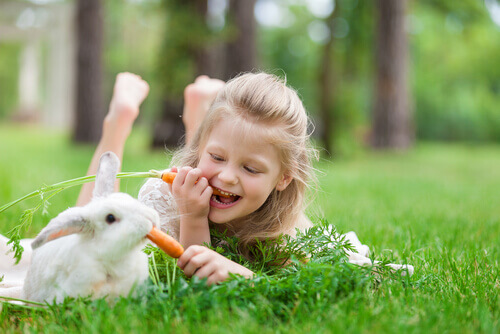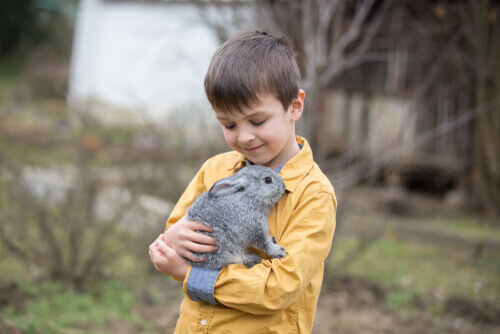What Does Therapy with Rabbits Consist Of?


Written and verified by the biologist Ana Díaz Maqueda
For centuries, many people have used trained animals to improve human beings’ emotional state. This can be as simple as enjoying an animal’s company. In addition, some species can offer direct physical support during certain types of rehabilitation. There’s even a type of therapy with rabbits as a support animal.
In the world of animal-assisted therapy, there are many species involved, such as dogs, cats, chickens, turtles, pigs, fish, and horses. Each of them offers different types of support due to their temperaments, abilities, and ways of acting.
For example, dogs are extremely friendly and docile animals. As a result, they’re good at facilitating interaction. Horses also can help with physical rehabilitation and recovery of muscle tone.
Although humans have been probably been using animals for therapy for many years, the first documented case of a therapy animal was in 1792 in York Retreat, England. This facility used farm animals, such as rabbits, to help improve the mood of patients with mental illnesses.
Currently, it’s easy to see how dogs function as great assistance animals. However, there are many other options and each can offer different types of aid. We encourage you to continue reading and discover more about therapy with rabbits!
Why therapy with rabbits?
Animal-assisted therapy is a complementary method of rehabilitation from many human conditions, both physical and psychological. As we already mentioned, dogs are the most common therapy animal. However, people can also use rabbits as an alternative species.

There are several characteristics and qualities that make rabbits good therapy animals, in particular:
- Their small size
- Intelligence and friendliness towards humans
- Playfulness
- Ease of socializing
- Clear nonverbal communication to convey what they like and don’t like
In addition, it’s clear that children and rabbits can develop strong bonds. Rabbits are a popular childhood animal.
In fact, children’s literature is full of rabbits, and it’s normal for children between 7 to 10 years old to be attracted to these adorable animals. Therapy with rabbits can produce very positive feelings in children. In addition, rabbits can help improve their imagination.
According to studies from different children’s hospitals, rabbits are easily accepted by children with emotional or physical problems.
Benefits of therapy with rabbits
Like other types of animal therapy, therapy with rabbits brings many benefits to children’s health.
Promotes communication and expression
Playing with rabbits is a positive, relaxed, and fun experience. As a result, children are mentally stimulated. It makes them eager to share the experience with people they trust, such as their families or caregivers.
Encourages acceptance of physical contact
Some children who use therapy with rabbits have little physical contact with other people, due to a variety of causes. Rabbits are very cuddly creatures, which can encourage the children to develop contact communication skills.

Involves moments of relaxation
As with all therapy animals, being able to pet an animal calmly allows for some moments of relaxation. This can help decrease stress, which has significant benefits for the body and aids healing.
Caring for rabbits
When you work with therapy animals, you can’t forget that these are living animals with complex emotions and they deserve respect.
Therefore, during therapy sessions, an assistant is always present who follows a rigorous protocol that psychologists and veterinarians design. This way, animal welfare, and their physical and mental integrity are assured.
The great work of assistance animals
Through research and information from hospitals, nursing homes, and other institutions, it’s clear how beneficial assistance animals can be. However, this is still an area of research under development. We must continue to learn from animals while they learn from us.
All cited sources were thoroughly reviewed by our team to ensure their quality, reliability, currency, and validity. The bibliography of this article was considered reliable and of academic or scientific accuracy.
- Loukaki, K., Koukoutsakis, P., & Kostomitsopoulos, N. (2010). Animal welfare issues on the use of rabbits in an animal assisted therapy program for children. Journal of the Hellenic Veterinary Medical Society, 61(3), 220-225.
- Macauley, B. L. (2006). Animal-assisted therapy for persons with aphasia: A pilot study. Journal of rehabilitation research and development, 43(3), 357.
- Stanley-Hermanns, M., & Miller, J. (2002). Animal-Assisted Therapy: Domestic animals aren’t merely pets. To some, they can be healers. AJN The American Journal of Nursing, 102(10), 69-76.
- Parshall, D. P. (2003). Research and reflection: Animal‐assisted therapy in mental health settings. Counseling and Values, 48(1), 47-56.
This text is provided for informational purposes only and does not replace consultation with a professional. If in doubt, consult your specialist.